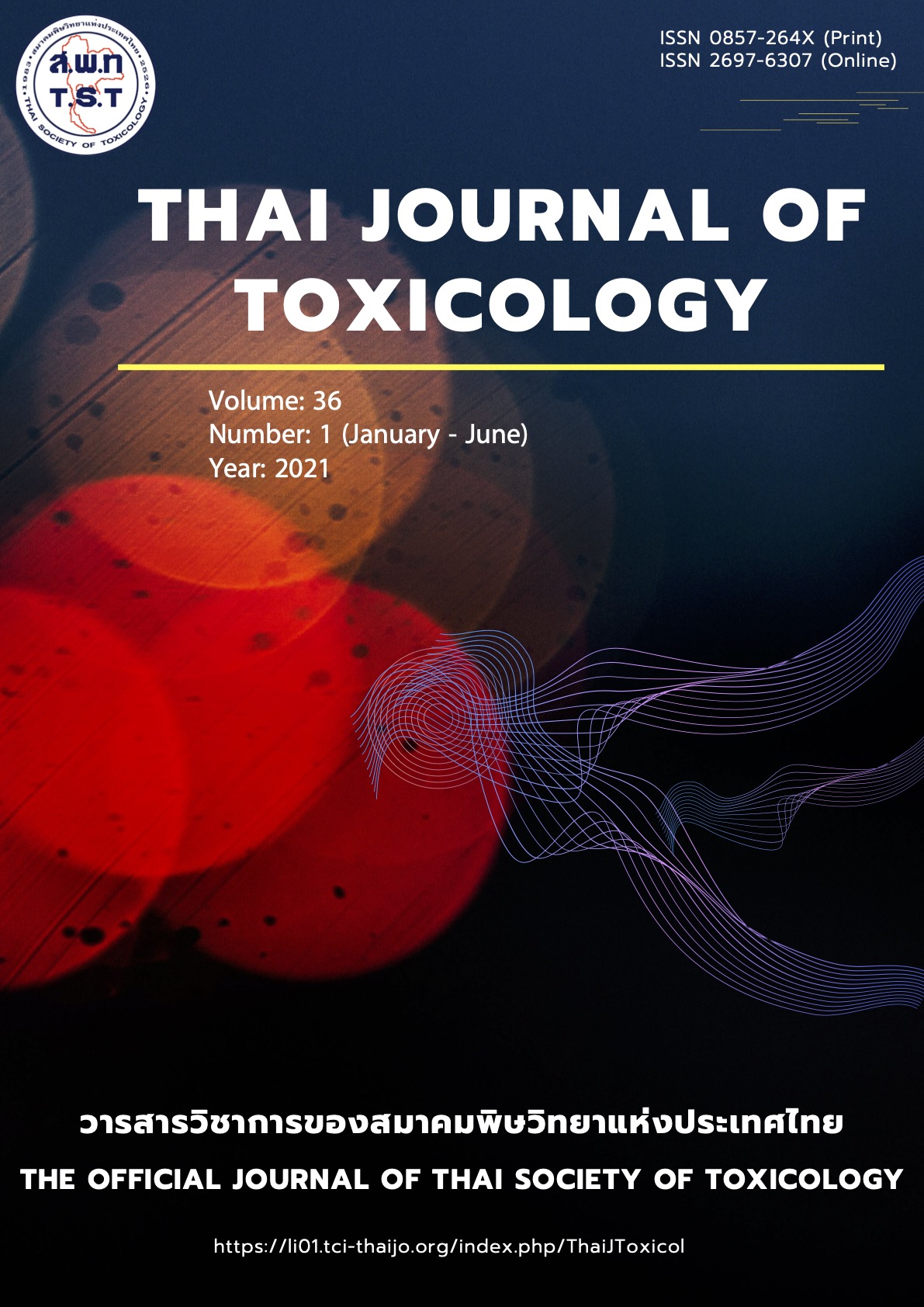การประเมินความเสี่ยงการได้รับสารป้องกันกำจัดศัตรูพืชกลุ่มคาร์บาเมตจากการบริโภคผักผลไม้ของประชากรไทย
Main Article Content
บทคัดย่อ
การศึกษานี้มีวัตถุประสงค์เพื่อประเมินความเสี่ยงการได้รับสารป้องกันกำจัดศัตรูพืชกลุ่มคาร์บาเมต จากการบริโภคผักและผลไม้ คำนวณปริมาณการได้รับสารเคมีกลุ่มคาร์บาเมต โดยใช้ข้อมูลการบริโภคอาหารของประเทศไทย และปริมาณสารเคมีกลุ่มคาร์บาเมตตกค้างจำนวน 7 ชนิด ได้แก่ คาร์บาริล คาร์โบ-ซัลแฟน คาร์โบฟูราน เมทิโอคาร์บ เมโทมิล ออกซามิล และอัลดิคาร์บ จากรายงานผลวิเคราะห์สารเคมีกลุ่ม คาร์บาเมตตกค้างในตัวอย่างผักผลไม้ จำนวน 55 ชนิด รวม 948 ตัวอย่าง ซึ่งได้รับความอนุเคราะห์จากสำนักงานคณะกรรมการอาหารและยา ผลการศึกษาไม่พบความเสี่ยงเกินค่าความปลอดภัยทั้งแบบเฉียบพลันและเรื้อรัง ในการประเมินความเสี่ยงจากการได้รับแบบเฉียบพลัน พบความเสี่ยงสูงสุดจากการได้รับคาร์โบ-ฟูรานจากการบริโภคส้ม คิดเป็นร้อยละ 74 ของค่าความปลอดภัยต่อสุขภาพแบบเฉียบพลัน (ARfD) นอกจากนี้พบว่าค่าความเสี่ยงของการได้รับคาร์โบฟูรานจากการบริโภคฝรั่งและถั่วฝักยาว คิดเป็นร้อยละ 20 และ14 ของค่า ARfD ตามลำดับ ผลการประเมินความเสี่ยงจากการได้รับสารเคมีแบบเรื้อรัง พบว่ามีความเสี่ยงต่ำมาก โดยค่าความเสี่ยงของการได้รับสารเคมีทุกชนิดต่ำกว่าร้อยละ 1 ของค่าความปลอดภัยต่อสุขภาพตลอดช่วงชีวิต (ADI) เมื่อประเมินความเสี่ยงรวมจากการบริโภคผักและผลไม้ที่ระดับเฉลี่ย พบว่ามีความเสี่ยงต่ำมาก โดยพบความเสี่ยงจากการได้รับคาร์โบฟูราน จากการบริโภคผักและผลไม้รวม เพียงร้อยละ 4.5 ของค่า ADI อย่างไรก็ตามเมื่อประเมินความเสี่ยงโดยใช้รูปแบบผู้บริโภคสูง ผลการประเมินพบความเสี่ยงจากการได้รับคาร์โบฟูราน สูงถึงร้อยละ 91 ของค่า ADI รองลงมาคืออัลดิคาร์บ (ร้อยละ 10 ของ ADI)
Article Details
เอกสารอ้างอิง
Laohaudomchok W, Nankongnab N, Siriruttanapruk S, et al. Pesticide use in Thailand: Current situation, health risks, and gaps in research and policy. Hum Ecol Risk Assess 2021; 27: 1–23.
Sapbamrer R. Pesticide use, poisoning, and knowledge and unsafe occupational practices in Thailand. New Solut 2018; 28: 283–302.
Zhang J, Guo J, Wu C, et al. Exposure to carbamate and neurodevelopment in children: evidence from the SMBCS cohort in China. Environ Res 2019; 177: 108590.
สำนักงานคณะกรรมการกฤษฎีกา. พระราชบัญญัติวัตถุอันตราย พ.ศ.2535. (2535 29 มีนาคม). Available at https://www.diw.go.th/hawk/law/haz/ Hazardous%20Substance%20Act.pdf, accessed on March 2, 2021.
WHO recommended classification of pesticides by hazard and guidelines to classification, 2019 edition. Geneva: World Health Organization, 2020.
Vale A, Lotti M. Organophosphorus and carbamate insecticide poisoning. Handb Clin Neurol 2015; 131: 149–68.
Wanwimolruk S, Kanchanamayoon O, Phopin K, et al. Food safety in Thailand 2: Pesticide residues found in Chinese kale (Brassica oleracea), a commonly consumed vegetable in Asian countries. Sci Total Environ 2015; 532: 447–55.
Wanwimolruk S, Phopin K, Boonpangrak S, et al. Food safety in Thailand 4: comparison of pesticide residues found in three commonly consumed vegetables purchased from local markets and supermarkets in Thailand. Peer J 2016; 4: e2432.
Wanwimolruk S, Duangsuwan W, Phopin K, et al. Food safety in Thailand 5: The effect of washing pesticide residues found in cabbages and tomatoes. J Consum Prot Food Saf 2017; 12: 209–21.
World Health Organization. Report of a Joint FAO/WHO workshop on fruit and vegetables for health, 2004. Available at http://apps.who.int/ iris/bitstream/handle/10665/43143/9241592818_eng.pdf;jsessionid=071C3AD8FB150E2E03068DC6F345D56C?sequence=1, accessed on Feb 10, 2021.
World Health Organization. Principles and methods for the risk assessment of chemicals in food. EHC 240, 2009. Available at http://www.who.int/ foodsafety/chem/principles/en/index1.html, accessed on Jan 18, 2021.
สำนักงานมาตรฐานสินค้าเกษตรและอาหารแห่งชาติ, ข้อมูลการบริโภคอาหารของประชากรไทย, สำนักกำหนดมาตรฐาน, สำนักงานมาตรฐานสินค้าเกษตรและอาหารแห่งชาติ. กระทรวงเกษตรและสหกรณ์. 2559.
World Health Organization. Joint FAO/WHO Meeting on Pesticide Residues (JMPR). Available at https://www.who.int/foodsafety/areas_work/ chemical-risks/jmpr/en/, accessed on Jan 18, 2021.
ประกาศกระทรวงสาธารณสุข เรื่อง อาหารที่มีสารพิษตกค้าง (ฉบับที่ 387) พ.ศ. 2560. (2560, 18 กันยายน). ราชกิจจานุเบกษา. เล่ม 134 ตอนพิเศษ 228 ง.
Wanwimolruk C, Phopin K, Wanwimolruk S. Food safety in Thailand 6: How to eat guava fruits safely? Effects of washing and peeling on removing pesticide residues in guava fruits. J Food Saf 2019; 39: e12654.
Suntudrob J, Jongmevasna W, Payanan T, et al. Monitoring of pesticide residues in domestic vegetables in Thailand during 2015. Asia Pac J Sci Technol 2018; 23: 1–8.
Chung SW. How effective are common household preparations on removing pesticide residues from fruit and vegetables? A review. J Sci Food Agric 2018; 98: 2857–70.
Srikote R, Jongmeewasna W. Minimizing pesticide residues in fruits and vegetables. Bull Med Sci 2021; 63: 38–50.


